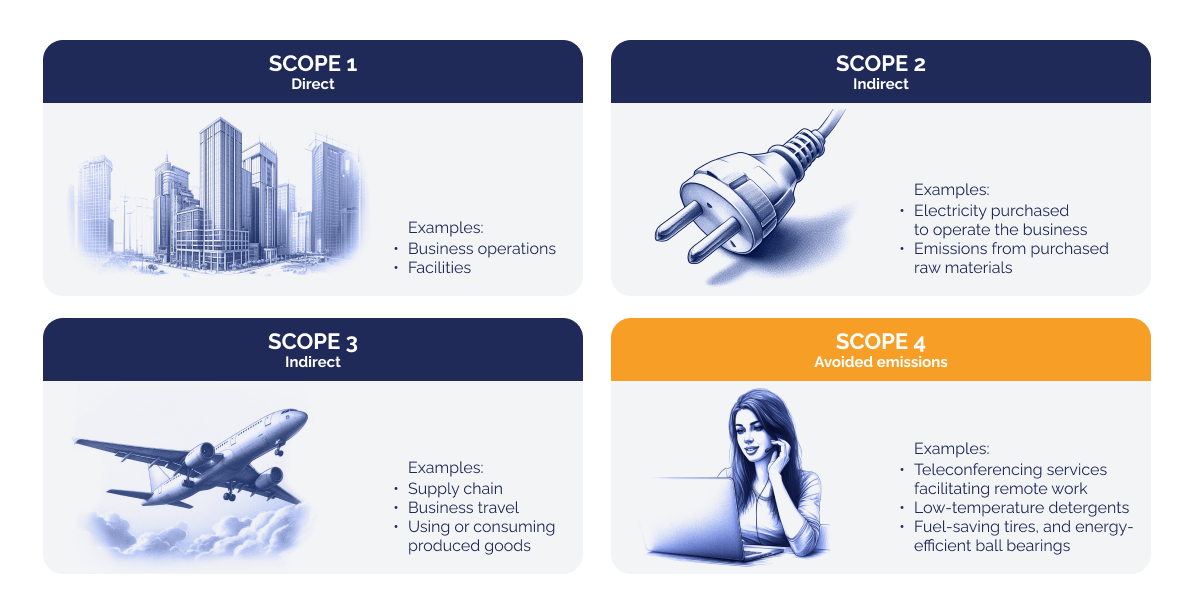In the world of environmental sustainability, understanding and mitigating carbon emissions have become critical components of corporate responsibility. The global focus on sustainable practices has given rise to comprehensive carbon reporting, shedding light on various emission scopes within an organisation.
 Photo of trees from below against a blue sky.
Photo of trees from below against a blue sky.
Amidst these reporting mechanisms, Scope 4 emissions have emerged as a significant factor in the environmental discourse. While Scopes 1, 2, and 3 have long been familiar, Scope 4 represents a new frontier, demanding attention and strategic management.
The importance of Scope 4 emissions stems from their indirect impact, covering activities that extend beyond a company's immediate purview. With the evolving landscape of industries and heightened environmental concerns, the imperative to take into account Scope 4 emissions has emerged as a pivotal aspect of corporate environmental stewardship.
Understanding Scope 4 emissions
To appreciate the nuances of Scope 4, a quick revisit to Scopes 1, 2, and 3 is essential. Scope 1 involves direct emissions from owned or controlled sources, and Scope 2 relates to indirect emissions from purchased energy. Scope 3 extends the spectrum to indirect emissions related to a company's value chain.
 Illustration describing essentials of Scope 1, 2, 3 and 4.
Illustration describing essentials of Scope 1, 2, 3 and 4.
Scope 4 emissions encompass a unique facet of carbon reporting, delving into avoided emissions. While traditional Scopes 1-3 focus on direct and certain indirect emissions within organisational boundaries, Scope 4 broadens the horizon. The World Resources Institute, creators of the Greenhouse Gas Protocol (GHG Protocol), introduced the term Scope 4. Originating in 2013, the GHG Protocol defines avoided emissions as reductions happening beyond a product's lifecycle or value chain but attributed to the product's usage.
Read more: Unveiling hidden carbon footprints: overlooked emissions sources in business operations
The most common use of the term Scope 4 emissions is to describe emissions avoided when a product is used as a substitute for other goods or services but with lower carbon intensity. This extends beyond the immediate organisational boundaries, encompassing scenarios like teleconferencing services facilitating remote work, thereby avoiding commuting-related emissions. Other examples include low-temperature detergents, fuel-saving tires, and energy-efficient ball bearings. This interpretation of Scope 4 emissions introduces a dynamic element, recognising emissions reductions occurring as a result of product use.
 A man working remotely from home.
A man working remotely from home.
Unlike the direct and indirect emissions covered in Scopes 1–3, Scope 4 requires a broader perspective. It involves considerations of avoided emissions and home-working emissions, emphasising the need for collaboration and data exchange throughout the entire supply chain. This holistic approach provides a more comprehensive understanding of a company's environmental impact, acknowledging the evolving landscape of carbon reporting.
Scope 3 vs Scope 4 emissions: unravelling the complexity
In understanding the complexity between Scope 3 and Scope 4 emissions, it's essential to highlight the unique contributions of each. While both scopes involve indirect impacts, Scope 3 traditionally covers emissions not owned or controlled by a company related to its value chain, including business travel, upstream and downstream transportation, and product life cycle. In contrast, Scope 4 introduces the concept of avoided emissions, extending the analysis beyond immediate organisational boundaries.
Read more: Uncovering the impact of Scope 3 emissions
Scope 4 emphasises the potential impact of products or services that lead to emissions reductions outside the traditional life cycle that contribute to emissions avoidance, showcasing a new dimension in carbon reporting. Scope 4 emissions are distinct from Scopes 1, 2, and 3 emissions, and as such, they should not be included when quantifying or offsetting the environmental impact of an entity.
Measurement and reporting of Scope 4 emissions
While reporting initiatives may not universally mandate reporting on avoided emissions, it is increasingly recognised as a crucial gap in disclosure. Initiatives like the Science-based Targets Initiative and CDP may not currently require such reporting, but the importance of addressing avoided emissions is gaining prominence, potentially driving environmental action among businesses.
The current reporting approach often focuses on emissions reduction progress. However, situations may arise where innovations, while temporarily increasing emissions during development, lead to substantial emissions reductions during product usage.
Read more: 5 Sustainable business practices to achieve net zero
Penalising companies for temporary emissions increases during innovation phases may deter vital advancements. The GHG Protocol suggests strategies like accounting for every stage of the product's life cycle, considering changes in consumer behaviour, and avoiding confusion between market size and impact. By providing a clear understanding of Scope 4, organisations can develop emissions scenarios that balance innovation and emissions reduction, fostering transparency for stakeholders.
Organisations can embed avoided emissions in reporting, creating a holistic view of their emissions inventory. Alternatively, they can allocate resources to research and development, aiming to innovate products in ways that do not increase emissions. The bottom line: while avoided emissions pose challenges in quantification, acknowledging and incorporating them into reporting is essential for a comprehensive understanding of an organisation’s emissions inventory and driving sustainable innovation.
Leading fund managers, particularly those focused on environmental solutions, are increasingly incorporating the quantification of positive environmental impact into their strategies. This involves the calculation of avoided emissions, such as Scope 4.
 A woman changing normal lamp bulb for power save one.
A woman changing normal lamp bulb for power save one.
Investors utilise avoided emissions metrics for pre-investment comparisons, aiding capital allocation to the most impactful investments based on the 'Carbon Yield’. Post-investment, this metric helps monitor and communicate quantitative environmental impact to investors. However, the absence of universally recognised standards for measurement poses challenges, leaving room for potential greenwashing practices. It's crucial for organisations to ensure the credibility of claims around emissions reductions and to avoid greenwashing, as recommended by the GHG Protocol.
Read more: How nature-based projects contribute to net-zero goals
While there is a need for an officially recognised standard for measuring avoided emissions, globally recognised frameworks, such as the Comparative Emissions Working Paper from the World Resources Institute and the Avoided Emissions Framework from Mission Innovation, offer credible guidance. Two methodological approaches, consequential and attributional, are employed in calculating avoided emissions. The consequential approach, though more holistic, is often constrained by information or time limitations, making the attributional approach more practical in practice.
The key lies in the details when calculating avoided emissions. The main considerations include choosing the reference product, determining the system boundary and time period, utilising reliable data sources, and addressing uncertainties. Fundamental principles across frameworks emphasise robustness, transparency, and balance in the calculation methodology. As fund managers increasingly focus on environmental solutions, enhanced disclosure of avoided emissions is anticipated, emphasising the critical need for robust and transparent methodologies that complement efforts to measure, disclose, and reduce portfolio emissions.
Scope 4 emissions’ impact on businesses
The environmental implications of Scope 4 emissions extend beyond a company's immediate operations, influencing ecosystems, biodiversity, and the environment in general. Integrating these emissions within a company’s broader sustainability plans is fundamental to achieving broader sustainability goals.
Incorporating Scope 4 emissions into sustainability strategies is essential for a comprehensive approach. Companies that recognise the interconnectedness of their operations and supply chain activities are better positioned to navigate the evolving landscape of corporate sustainability.
Measure your environmental impact
Future trends and developments
Innovations in technology, such as advanced logistics and renewable energy solutions, are poised to play a pivotal role in further increasing the amount of avoided emissions. Embracing these technologies will be crucial for companies looking to stay ahead of regulatory and consumer expectations.
Anticipating and adapting to evolving regulations and global initiatives is imperative. Governments and international bodies are increasingly emphasising the need for comprehensive emission reduction strategies, including Scope 4 considerations.
The future of emissions management will likely see an increased emphasis on holistic environmental responsibility. Companies that proactively take into account Scope 4 emissions will not only meet evolving standards but also contribute to a more sustainable global ecosystem.
Become nature-positive with DGB Group
In essence, a profound understanding and proactive approach to Scope 4 emissions are fundamental for adopting a comprehensive and responsible stance towards environmental sustainability. Businesses have all the right reasons to evaluate and quantify their Scope 4 emissions, recognising their operations’ impact on the environment. Embracing the significance of Scope 4 emissions is a crucial stride as we navigate the future of emissions management, fostering a sustainable and resilient global economy.
This encompassing guide is tailored to provide unique insights and strategic direction for businesses committed to navigating the intricate terrain of Scope 4 emissions, paving the way for a more sustainable future. Scope 4 emissions have the potential to bring the journey towards net-zero emissions to completion. At DGB Group, we are dedicated to assisting companies in realising their sustainability goals and reaching net zero. Our large-scale projects produce top-quality carbon credits meticulously crafted to offset emissions that may prove challenging to abate.
Global action and collaboration are imperative for a sustainable, healthy future. Collaborating with diverse stakeholders, DGB ensures the impactful nature of our projects, not only sequestering carbon emissions but also benefiting the environment and local communities.
Taking decisive action on emissions serves as a powerful demonstration of your company's commitment to environmental responsibility, resonating with eco-conscious consumers and investors alike. Embark on your sustainability journey by measuring your company’s carbon footprint today.
Start your green journey with our carbon footprint analysis




